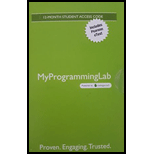
Concept explainers
(a)
To choose a suitable word for a blank.
(a)
Explanation of Solution
Answer: Files
Explanation: A file is a collection of data that is stored in the storage devices.
(b)
To choose a suitable word for a blank.
(b)
Explanation of Solution
Answer: Record
Explanation: The data can be stored in the form of the fields in the record.
(c)
To choose a suitable word for a blank.
(c)
Explanation of Solution
Answer: Key
Explanation: To retrieve the data from the record, something unique is required, that is, a key.
(d)
To choose a suitable word for a blank.
(d)
Explanation of Solution
Answer: String
Explanation: A set of characters is known as a string.
(e)
To choose a suitable word for a blank.
(e)
Explanation of Solution
Answer: Standard input, standard output, and standard error
Explanation: These are the basic streams required for the file operations.
(f)
To choose a suitable word for a blank.
(f)
Explanation of Solution
Answer: fputc
Explanation: A fputc() is a pre-defined function to write a character to the file.
(g)
(g)
Explanation of Solution
Answer: fputs
Explanation: A fputs() is a pre-defined function to write a string to the file.
(h)
To choose a suitable word for a blank.
(h)
Explanation of Solution
Answer: fwrite
Explanation: Generally, a fwrite() function is used to write to a file.
(i)
To choose a suitable word for a blank.
(i)
Explanation of Solution
Answer: fseek
Explanation: A fseek() function will move the pointer to the starting of the file.
Want to see more full solutions like this?
Chapter 11 Solutions
MYPROGRAMMINGLAB WITH PEARSON ETEXT
 C++ for Engineers and ScientistsComputer ScienceISBN:9781133187844Author:Bronson, Gary J.Publisher:Course Technology PtrProgramming Logic & Design ComprehensiveComputer ScienceISBN:9781337669405Author:FARRELLPublisher:Cengage
C++ for Engineers and ScientistsComputer ScienceISBN:9781133187844Author:Bronson, Gary J.Publisher:Course Technology PtrProgramming Logic & Design ComprehensiveComputer ScienceISBN:9781337669405Author:FARRELLPublisher:Cengage Microsoft Visual C#Computer ScienceISBN:9781337102100Author:Joyce, Farrell.Publisher:Cengage Learning,
Microsoft Visual C#Computer ScienceISBN:9781337102100Author:Joyce, Farrell.Publisher:Cengage Learning, Systems ArchitectureComputer ScienceISBN:9781305080195Author:Stephen D. BurdPublisher:Cengage Learning
Systems ArchitectureComputer ScienceISBN:9781305080195Author:Stephen D. BurdPublisher:Cengage Learning Fundamentals of Information SystemsComputer ScienceISBN:9781305082168Author:Ralph Stair, George ReynoldsPublisher:Cengage Learning
Fundamentals of Information SystemsComputer ScienceISBN:9781305082168Author:Ralph Stair, George ReynoldsPublisher:Cengage Learning EBK JAVA PROGRAMMINGComputer ScienceISBN:9781337671385Author:FARRELLPublisher:CENGAGE LEARNING - CONSIGNMENT
EBK JAVA PROGRAMMINGComputer ScienceISBN:9781337671385Author:FARRELLPublisher:CENGAGE LEARNING - CONSIGNMENT





